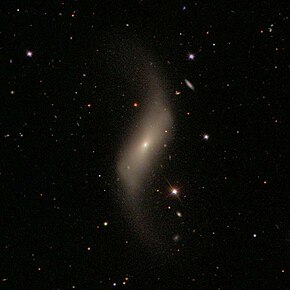NGC 4488
Appearance
| NGC 4488 | |
|---|---|
 NGC 4488 | |
| Observation data (J2000 epoch) | |
| Constellation | Virgo |
| Right ascension | 12h 30m 51.4s[1] |
| Declination | 08° 21′ 36″[1] |
| Redshift | 0.003242/972 km/s[1] |
| Distance | 58.7 Mly |
| Group or cluster | Virgo Cluster |
| Apparent magnitude (V) | 13.1[1] |
| Characteristics | |
| Type | SB0/a(s) pec [1] |
| Size | ~35,000 ly |
| Apparent size (V) | 3.17 x 0.87[1] |
| Other designations | |
| CGCG 70-137, MCG 2-32-104, PGC 41363, UGC 7653, VCC 1318[1] | |
NGC 4488 is a lenticular galaxy[2][3] located about 60 million light-years away[3] in the constellation of Virgo.[4] The galaxy was discovered by astronomer William Herschel on December 28, 1785.[2] NGC 4488 is a member of the Virgo Cluster.[5][6]
Structure
NGC 4488 has an unusual rectangular shaped structure similar to the galaxy LEDA 74886. The galaxy does not have an inner disk. It also has two arms coming off diagonally opposite sides suggesting that NGC 4488 has had a gravitational interaction with another galaxy.[7]
See also
References
- ^ a b c d e f g "NASA/IPAC Extragalactic Database". Results for NGC 4488. Retrieved 2017-08-11.
- ^ a b "New General Catalog Objects: NGC 4450 - 4499". cseligman.com. Retrieved 2017-08-12.
- ^ a b "Your NED Search Results". ned.ipac.caltech.edu. Retrieved 2017-08-12.
- ^ Rojas, Sebastián García. "Galaxy NGC 4488 - Galaxy in Virgo Constellation · Deep Sky Objects Browser". DSO Browser. Retrieved 2017-08-12.
- ^ "The Virgo Cluster". www.atlasoftheuniverse.com. Retrieved 2017-08-12.
- ^ "Detailed Object Classifications". ned.ipac.caltech.edu. Retrieved 2017-08-12.
- ^ Graham, Alister W.; Spitler, Lee R.; Forbes, Duncan A.; Lisker, Thorsten; Moore, Ben; Janz, Joachim (10 May 2012). "Leda 074886: A Remarkable Rectangular-Looking Galaxy". The Astrophysical Journal. 750:121 (2): 5. arXiv:1203.3608. Bibcode:2012ApJ...750..121G. doi:10.1088/0004-637X/750/2/121. S2CID 28425342.
External links
Wikimedia Commons has media related to NGC 4488.
- NGC 4488 on WikiSky: DSS2, SDSS, GALEX, IRAS, Hydrogen α, X-Ray, Astrophoto, Sky Map, Articles and images
